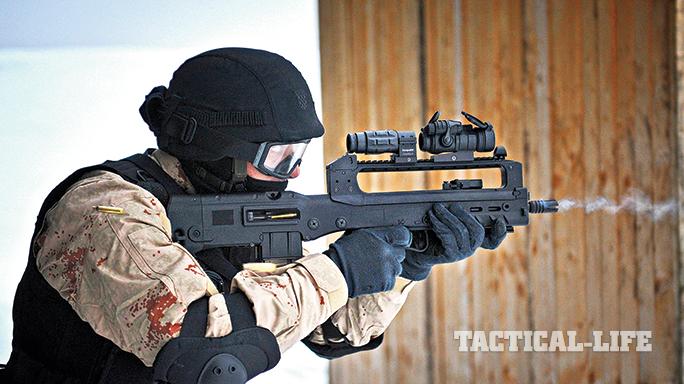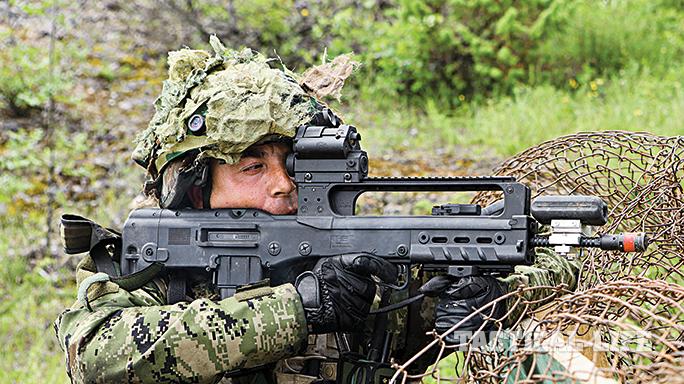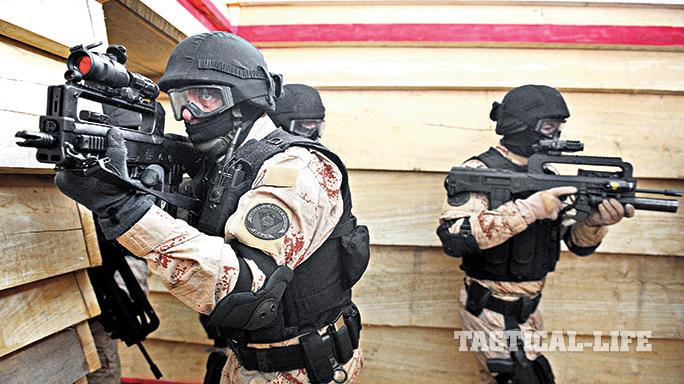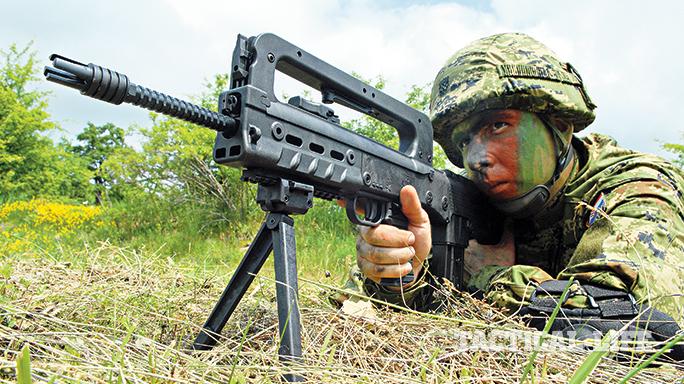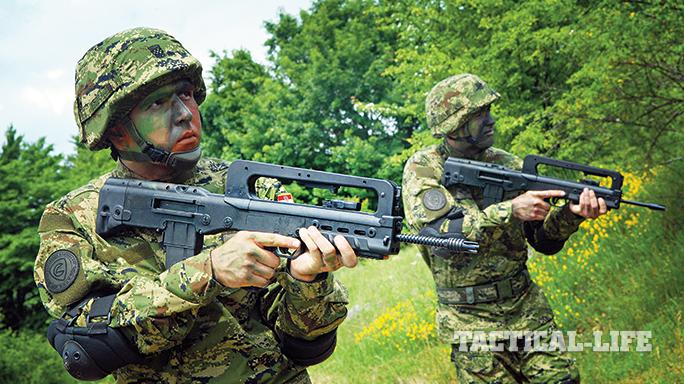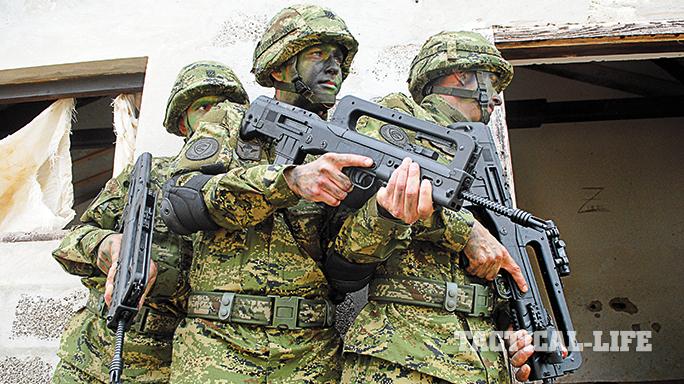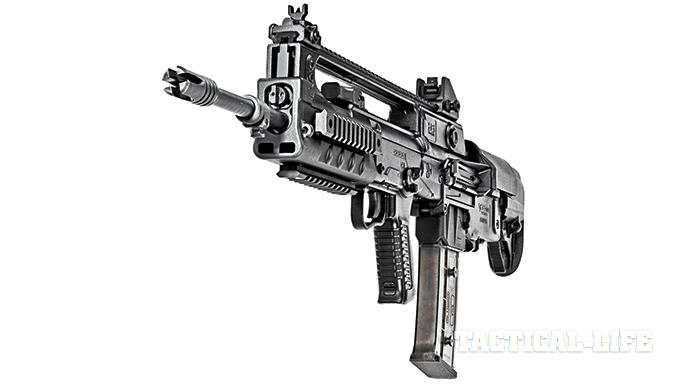Croatia is located in southeastern Europe, with a coastline on the Adriatic Sea. It is slightly smaller than the U.S. state of West Virginia and borders the nations of Bosnia and Herzegovina, Hungary, Montenegro, Slovenia and Serbia. It won its independence from Yugoslavia in 1991 by fighting a bitter war over a period of four years to establish its status as a sovereign country. Since that time it has become an important part of the international community of nations. Croatia joined the North Atlantic Treaty Organization (NATO) in 2009 and the European Union in 2013.
- RELATED: Croatian Combat Pistols From HS Produkt, Springfield
- RELATED: 12 Guns from IWA 2014, Europe’s Largest Firearms Expo
As a newly independent nation, Croatia wanted to build a professional and well-equipped military force that could be integrated into the logistics system of NATO. To do this, Croatia decided to move away from 7.62x39mm Kalashnikov-type weapons and standardize a service rifle chambered in 5.56x45mm NATO. The result was the VHS series of rifles manufactured by Croatian arms manufacturer HS Produkt. HS Produkt began making pistols in 1991 to supply the then-fledgling Croatian military. At the request of the Ministry of Defence, HS Produkt soon started the required research and development for a domestically made infantry rifle. The first prototypes of the VHS rifle appeared publicly in 2005, and in 2007 field trials began with the Croatian armed forces.
Bullpup Specs
Advertisement — Continue Reading Below
VHS stands for Višenamjenska Hrvatska Strojnica in Croatian, which roughly translates into English as “Croatia multi-purpose machine gun.” The VHS is a bullpup-type rifle, with the action and the magazine located behind the trigger group. An advantage of the bullpup design is that it has a shorter overall length while retaining a full-length rifle barrel. For a soldier, this means improved maneuverability and reduced weight. Two barrel lengths are available. The long-barrel version is known as the VHS-D, and the short-barrel version is known as the VHS-K. The “D” stands for the Croatian word dugo, meaning long in English, while the letter “K” stands for kratke, meaning short.
“Operations conducted in the Middle East and Africa have proven that the design works in real-world combat scenarios.”
The barrel length on the VHS-D is 19.68 inches, and it is designed to mount a bayonet and can be used for launching rifle grenades. With an overall length of slightly more than 31 inches, it is meant to be a standard infantry rifle that provides full-size rifle performance while still being compact. The VHS-K has a barrel length of 16.14 inches and is designed to be as compact as possible with an overall length of just over 27 inches. The VHS-K can be used as a personal-defense weapon and is also ideal for use in close-quarters battle situations. The VHS-K bullpup cannot accept a bayonet or fire rifle grenades.
Advertisement — Continue Reading Below
Between 2007 and 2011, the VHS was used in limited numbers by the Croatian military as part of its final developmental testing. This culminated with the VHS being deployed overseas on peacekeeping duties in the Golan Heights, Sierra Leone and for combat use in Afghanistan. In 2012, the VHS was fully certified by the Croatian Ministry of Defence as operational, and it was to be standardized as the country’s service rifle. As good as the VHS was found to be there was always room for improvement. HS Produkt introduced second-generation VHS production rifles, known as the VHS-D2 and VHS-K2, to the market in 2013.
“By all accounts, the VHS rifle is well liked by Croatian soldiers and civilian shooters in European nations that allow ownership of select-fire rifles.”
The changes made to the VHS-D2 and VHS-K2 were primarily incorporated to make them both truly ambidextrous and to provide improved ergonomics. The choice of two barrel lengths remains unchanged, but the overall length can now be changed by the shooter by means of a five-position-adjustable stock. This allows adjustment for shooters with different arm lengths and for when body armor is being worn. An ambidextrous three-position selector switch is located on both sides of the rifle just above the pistol grip. The position of the selector makes it easy for right- and left-handed shooters to use the weapon. Pictogram selector markings are used, with indications for safe, semi-automatic and fully automatic fire.
Advertisement — Continue Reading Below
A long carrying handle is integrated into the design, and a non-reciprocating, folding, ambidextrous charging handle is located on top of the receiver, inside of the carrying handle. The top of the carrying handle has a long NATO STANAG 4694 accessory rail that can accommodate optics of various lengths as well as iron sights. The Croatian military has used German Hensoldt, Swedish Aimpoint as well as domestically produced optics on the VHS. The long accessory rail on top leaves room for additional magnifiers, night vision or thermal imagers to supplement the primary day optic. A forearm available for the second-generation VHS rifles also has STANAG 4694 accessory rails on the bottom, right and left sides. The bottom rail can be used for mounting a vertical grip or bipod while the right and left side rails can be used to mount flashlights and laser-aiming devices.
Enhanced Design
HS Produkt also makes a 40x46mm low-velocity grenade launcher specifically for the VHS rifle. This weapon is known as the VHS-BG, the letters BG standing for bacac granata or grenade launcher. Users must simply remove the rifle’s forearm and replace it with the grenade launcher assembly. This can be done in a matter of seconds without the use of tools.
Advertisement — Continue Reading Below
The single-shot launcher is capable of firing a full range of lethal and less-lethal rounds and, in the hands of a trained grenadier, can be accurately fired at a rate of five to seven rounds per minute. HS Produkt also makes an integrated stock assembly with a pistol grip and sights that allows the VHS-BG grenade launcher to be used as a standalone weapon.
HS Produkt designed a 30-round magazine constructed of extremely durable polymer to feed the VHS rifle. The polymer material is translucent, allowing the shooter to monitor ammunition levels visually. To facilitate rapid reloading in combat, the magazines can be coupled together using a pair of mounting lugs molded into the sides of the magazines. The magazine is inserted or removed from the rifle by a simple straight up and down motion. The magazine release, located at the rear of the magazine well, is easily manipulated by the shooter’s weak-hand thumb. An alternate magazine well assembly that accepts M16-type magazines is also available from HS Produkt. In another step to make it ambidextrous, shooters can configure the VHS-D2 and VHS-K2 to eject spent cartridge casings to either the left or right sides.
By all accounts, the VHS rifle is well liked by Croatian soldiers and civilian shooters in European nations that allow ownership of select-fire rifles. Operations conducted in the Middle East and Africa have proven that the design works in real-world combat scenarios. Due to the well-thought-out design features of the second-generation VHS-D2 and VHS-K2, they will probably gain much attention from military and police customers around the world. A semi-automatic-only version, should it ever be offered, would undoubtedly be of great interest to the civilian shooting market. Current and future generations of the VHS rifle will probably enjoy a long production run, no matter what.
Advertisement — Continue Reading Below
For more information, visit hs-produkt.hr/en.
